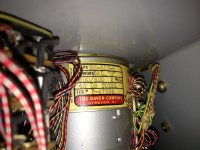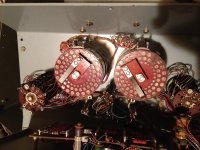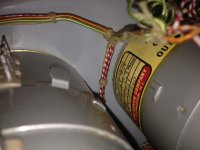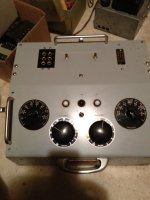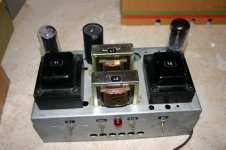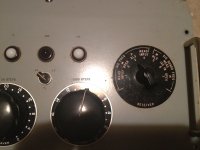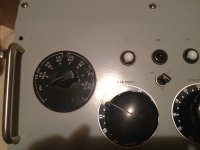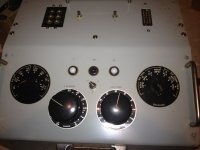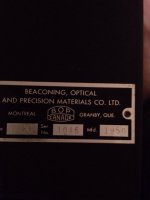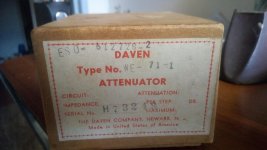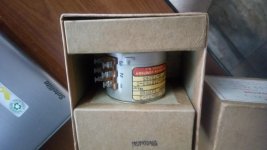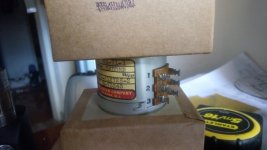Received an old piece of test equipment today (not sure what it is though to be honest, guy I got it from worked as a radio engineer), and opened it up to see if there is anything interesting in there. Found a couple what look and sound like attenuators to me. Both are made by The Daven Company, the first's marking indicate its 600/600 ohm, 2db/step, while the second one indicate its 600/600 .1db/step. I can't find much info based on the model name on a quick Google search, but I did run into some people posting good things about Daven attenuators. Anyone here have any more info for me?
I've attached a couple pics of the parts to help. There wasn't really anything else of interest in the case, a couple selector switches and that kind of a deal.
I've attached a couple pics of the parts to help. There wasn't really anything else of interest in the case, a couple selector switches and that kind of a deal.
Attachments
Last edited:
First attenuator:
Type: BH-520-G
Network: bal "H"
600/600 1db/step
40db total
Second:
Type: BH-525-G
Network: bal "H"
600/600 .1dn/step
2db total
As for using them as level controls instead of pots, that was my idea for them, though I'm not sure how I'd need to modify them. Any tips or links to reading material is appreciated. I'll have to spend more time researching it tomorrow, now its time for bed.
Type: BH-520-G
Network: bal "H"
600/600 1db/step
40db total
Second:
Type: BH-525-G
Network: bal "H"
600/600 .1dn/step
2db total
As for using them as level controls instead of pots, that was my idea for them, though I'm not sure how I'd need to modify them. Any tips or links to reading material is appreciated. I'll have to spend more time researching it tomorrow, now its time for bed.
Last edited:
It looks like you have a piece of telephone central office test gear. "Automatic Electric" manufactured PBX and central office equipment for smaller, non-Bell System phone companies. (If memory serves, Automatic Electric was a direct descendent of the company founded by Mr Strowger to manufacture the automated telephone exchange switch he invented about 1900.) Judging by visual aesthetics, I'd guess that your test set is 1960's or 1970's vintage.
The Daven attenuators were legendary for their long life and noise-free operation. In a high-operation application like a broadcast console they were expected to last almost forever if the tech staff gave them a shot of contact cleaner every year or so. (Hence, the removable can on the back side.) If a console was ever scrapped or damaged beyond repair it wasn't unusual to salvage the attenuators.
Your attenuators are labeled as "Balanced H-pad" networks. You can seed a search engine to find references for this circuit; it's essentially the balanced version of the constant impedance T-pad. Since the 0.1 dB/step unit is in the same test set as a 2 dB/step unit, I'd wager that the 2 dB/step unit is a high-accuracy model. I can't tell for sure from the photos - are they dual-section (stereo) units?
In the "good old days" (formerly known as "these trying times"), telco and pro-audio line-level interfaces were usually 600 ohms for both inputs and outputs, and attenuators such as yours interposed between sources and loads. This allowed (among other things) output drivers to operate at a constant level into a known resistive load, and inputs were driven from a known, constant, source impedance. This arrangement had advantages in the areas of predictability, noise, and distortion performance. The main disadvantage is that half of the available voltage swing was dropped across the internal impedance. Attenuators were also used (as in your test set) as accurate measuring instruments. It was easier to build resistive attenuators with the desired initial accuracy, repeatability, and low drift than to design and build a precision metering circuit (and keep it calibrated).
Today most equipment has low output impedance, high input impedance; simple potentiometers are used to set levels and the gear is designed to tolerate a fairly wide range of source and load impedances. In light of that technological evolution your attenuators may qualify as historical artifacts. However, they are still high-performance units and it seems a waste to destroy the accuracy by replacing the resistors. The 0.1 dB/step in particular is not nearly as common as 1 dB- or 2 dB/step units. With a little research you may discover that their value as used test gear is enough for you to purchase a high-quality, audio step-pot that is already well suited for your intended application.
If you have access to the necessary resistor values in tight-tolerances (better than 1%) then there is a case for rebuilding them as, say, attenuators with 1K, 2.5K, or 10K characteristic impedances. To use them as-is you could place them between impedance-matching transformers from, e.g., Jensen or Lundahl. You could also design a 2-resistor impedance-matching L-pad for the input. This would raise the input impedance to a level (say, a few kilohms) that your driver stage can live with - but will also reduce the signal level.
Dale
The Daven attenuators were legendary for their long life and noise-free operation. In a high-operation application like a broadcast console they were expected to last almost forever if the tech staff gave them a shot of contact cleaner every year or so. (Hence, the removable can on the back side.) If a console was ever scrapped or damaged beyond repair it wasn't unusual to salvage the attenuators.
Your attenuators are labeled as "Balanced H-pad" networks. You can seed a search engine to find references for this circuit; it's essentially the balanced version of the constant impedance T-pad. Since the 0.1 dB/step unit is in the same test set as a 2 dB/step unit, I'd wager that the 2 dB/step unit is a high-accuracy model. I can't tell for sure from the photos - are they dual-section (stereo) units?
In the "good old days" (formerly known as "these trying times"), telco and pro-audio line-level interfaces were usually 600 ohms for both inputs and outputs, and attenuators such as yours interposed between sources and loads. This allowed (among other things) output drivers to operate at a constant level into a known resistive load, and inputs were driven from a known, constant, source impedance. This arrangement had advantages in the areas of predictability, noise, and distortion performance. The main disadvantage is that half of the available voltage swing was dropped across the internal impedance. Attenuators were also used (as in your test set) as accurate measuring instruments. It was easier to build resistive attenuators with the desired initial accuracy, repeatability, and low drift than to design and build a precision metering circuit (and keep it calibrated).
Today most equipment has low output impedance, high input impedance; simple potentiometers are used to set levels and the gear is designed to tolerate a fairly wide range of source and load impedances. In light of that technological evolution your attenuators may qualify as historical artifacts. However, they are still high-performance units and it seems a waste to destroy the accuracy by replacing the resistors. The 0.1 dB/step in particular is not nearly as common as 1 dB- or 2 dB/step units. With a little research you may discover that their value as used test gear is enough for you to purchase a high-quality, audio step-pot that is already well suited for your intended application.
If you have access to the necessary resistor values in tight-tolerances (better than 1%) then there is a case for rebuilding them as, say, attenuators with 1K, 2.5K, or 10K characteristic impedances. To use them as-is you could place them between impedance-matching transformers from, e.g., Jensen or Lundahl. You could also design a 2-resistor impedance-matching L-pad for the input. This would raise the input impedance to a level (say, a few kilohms) that your driver stage can live with - but will also reduce the signal level.
Dale
Your attenuators are labeled as "Balanced H-pad" networks. You can seed a search engine to find references for this circuit; it's essentially the balanced version of the constant impedance T-pad. Since the 0.1 dB/step unit is in the same test set as a 2 dB/step unit, I'd wager that the 2 dB/step unit is a high-accuracy model. I can't tell for sure from the photos - are they dual-section (stereo) units?
They are stereo units, yes.
Today most equipment has low output impedance, high input impedance; simple potentiometers are used to set levels and the gear is designed to tolerate a fairly wide range of source and load impedances. In light of that technological evolution your attenuators may qualify as historical artifacts. However, they are still high-performance units and it seems a waste to destroy the accuracy by replacing the resistors. The 0.1 dB/step in particular is not nearly as common as 1 dB- or 2 dB/step units. With a little research you may discover that their value as used test gear is enough for you to purchase a high-quality, audio step-pot that is already well suited for your intended application.
Apart from ebay, do you have any suggestions as to where I may find an interested party in purchasing the attenuators? I was planning on rebuilding them, but if they have a significant value, they would help fund my F5 build.
Thanks for the help.
surplus sales gets premium prices for most things...
they are nice rebuilt w/MF resistors...
they are two circuit units, not stereo unless two are stacked back to back from the factory - they are various "pads", L, H, T, etc...
I will buy all you got at $5-10 a piece. Especially the dual units.
_-_-bear
they are nice rebuilt w/MF resistors...
they are two circuit units, not stereo unless two are stacked back to back from the factory - they are various "pads", L, H, T, etc...
I will buy all you got at $5-10 a piece. Especially the dual units.
_-_-bear
Daven Attenuator model we-71-1 200Kohm 21steps mono
hi, i sell an daven attenuattor new. In original box 80 us dollars. Ship according with the buyer.
The item are in Caracas Venezuela.
hi, i sell an daven attenuattor new. In original box 80 us dollars. Ship according with the buyer.
The item are in Caracas Venezuela.
Attachments
- Status
- This old topic is closed. If you want to reopen this topic, contact a moderator using the "Report Post" button.
- Home
- Design & Build
- Parts
- Parts Identification - The Daven Company
